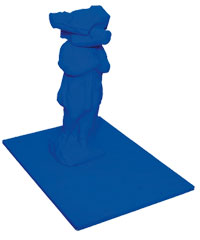In 1962, Klein created his last series of figurative sculptures, which were made by sponge-painting his patented International Klein Blue (IKB) formula on souvenir plaster casts purchased mainly from the Louvre. The casts were small-scale reproductions of a Venus (a Roman copy of the Aphrodite of Cnidus attributed to Praxiteles), Michelangelo’s Dying Slave, the Nike of Samothrace, and The Beheaded Boy… (and the Priest) by an unknown Renaissance artist, whose missing head Klein replaced with two souvenir figurines of the legendary Cypriot leader Archbishop Makarios. By dousing these renowned masterpieces with his signature IKB color Klein created objects that were blatantly corny. His choice, moreover, of appropriations is also significant in that each echoes a particular preoccupation of his.
The Nike of Samothrace, a figure in flight, references his landmark Leap into the Void.
The Dying Slave invokes themes similar to his Βattle Anthropometrics and his obsession with issues of death and freedom.
The Venus shares an affinity with the headless, truncated torsos in his Static Anthropometrics, although one can speculate that The Beheaded Boy… (and the Priest) touched Klein on a more personal level.
The souvenir plaster figurines of the Archbishop Makarios were given to Klein by a close friend, the chemist Bernard Furth, who, on holiday in the Seychelles in 1958, learned much about the life and personality of the charismatic spiritual and political leader exiled there by the British Empire from 1956 to 1959.
Biographical noteKlein is known for having led a somewhat double life since early childhood, with extended visits to his mother’s sister, Rose (whom he called Tantine), where he lived a more disciplined and luxurious life, in contrast to the rather unconventional life that his artist-parents provided. His shuttling between these two environments forced him into different roles that enabled him to gradually formulate his own myth in adulthood. It is not certain whether Klein’s placing the figure of the Archbishop (a figure who engineered his own myth vs. history relationship) on the boy’s neck was a biographical gesture ― but it certainly was poetic.
